Wai-Fah Chen.The Civil Engineering Handbook
Подождите немного. Документ загружается.

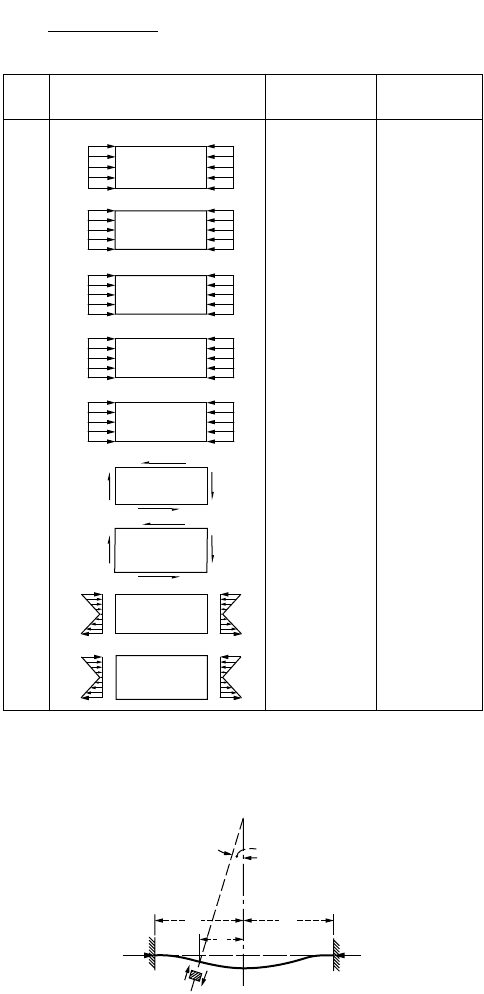
Theory and Analysis of Structures 47-161
Buckling of Shells
If a circular cylindrical shell is uniformly compressed in the axial direction, buckling symmetrical with
respect to the axis of the cylinder (Fig. 47.129) may occur at a certain value of the compressive load. The
critical value of the compressive force N
cr
per unit length of the edge of the shell can be obtained by
solving the differential equation
FIGURE 47.127 Values of K for plate with different boundary and loading conditions.
FIGURE 47.128 Circular plate under compressive loading.
s.s.
s.s.
s.s.
s.s.
s.s.
s.s. s.s.
s.s.
s.s.
s.s.
s.s.
s.s.
s.s.
s.s.
Fixed
Fixed
s.s.
s.s. s.s.
Free
s.s. s.s.
Free
Fixed
s.s. s.s.
s.s.
Fixed
Fixed
Fixed Fixed
Fixed
Fixed
Fixed Fixed
Fixed
Case
Boundary condition
Type of
stress
(a)
(b)
(c)
(d)
(e)
(f)
(g)
(h)
(i)
Compression
Compression
Compression
Compression
Compression
Shear
Shear
Bending
Bending
Value of k for
long plate
4.0
6.97
0.425
1.277
5.34
8.98
23.9
41.8
5.42
f
cr
=
k
12(1 − m
2
)(
w
/
t
)
2
π
2
E
r
0
N
r
Q
Q
N
r
r
0
r
ϕ
O
0
© 2003 by CRC Press LLC

47-162 The Civil Engineering Handbook, Second Edition
(47.357)
in which a is the radius of the cylinder and h is the wall thickness.
Alternatively, the critical force per unit length may also be obtained by using the energy method. For
a cylinder of length L, simply supported at both ends, one obtains
(47.358)
For each value of m there is a unique buckling mode shape and a unique buckling load. The lowest value
is of greatest interest and is thus found by setting the derivative of N
cr
with respect to L equal to zero for
m = 1. With Poisson’s ratio equal to 0.3, the buckling load is obtained as
(47.359)
It is possible for a cylindrical shell to be subjected to uniform external pressure or to the combined action
of axial and uniform lateral pressure.
47.13 Dynamic Analysis
Equation of Motion
The essential physical properties of a linearly elastic structural system subjected to external dynamic
loading are its mass, stiffness properties, and energy absorption capability or damping. The principle of
dynamic analysis may be illustrated by considering a simple single-story structure, as shown in Fig. 47.130.
The structure is subjected to a time-varying force f(t). k is the spring constant that relates the lateral
story deflection x to the story shear force, and the dash pot relates the damping force to the velocity by
a damping coefficient c. If the mass, m, is assumed to concentrate at the beam, the structure becomes a
single-degree-of-freedom (SDOF) system. The equation of motion of the system may be written as
(47.360)
Various solutions to Eq. (47.360) can give insight into the behavior of the structure under dynamic
situations.
Free Vibration
In this case the system is set to motion and allowed to vibrate in the absence of applied force f(t). Letting
f(t) = 0, Eq. (47.360) becomes
FIGURE 47.129 Buckling of a cylindrical shell.
L
x
z
y
V
cr
N
cr
L
w
2a
D
dw
dx
N
dw
dx
Eh
w
a
4
4
2
22
0++=
ND
m
L
EhL
Da m
cr
=+
Ê
Ë
Á
ˆ
¯
˜
22
2
2
222
p
p
N
Eh
a
cr
= 0 605
2
.
mx cx kx f t
˙˙ ˙
++ =
()
© 2003 by CRC Press LLC
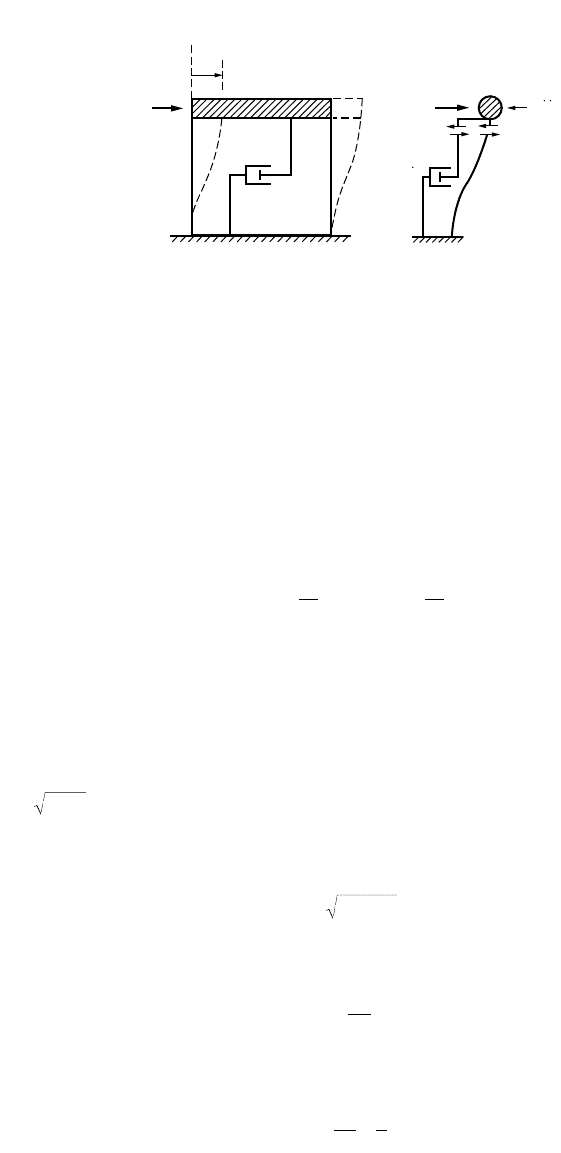
Theory and Analysis of Structures 47-163
(47.361)
Dividing Eq. (47.361) by the mass, m, we have
(47.362)
where
(47.363)
The solution to Eq. (47.362) depends on whether the vibration is damped or undamped.
Example 47.16: Undamped Free Vibration
In this case, c = 0, and the solution to the equation of motion may be written as
(47.364)
where is the circular frequency. A and B are constants that can be determined by the initial
boundary conditions. In the absence of external forces and damping, the system will vibrate indefinitely
in a repeated cycle of vibration with an amplitude of
(47.365)
and a natural frequency of
(47.366)
The corresponding natural period is
(47.367)
The undamped free vibration motion, as described by Eq. (47.364), is shown in Fig. 47.131.
FIGURE 47.130 (a) One DOF structure. (b) Forces applied to structures.
x
m
c
f(t)
k
(a) 1 DOF Structure
(b) Forces applied
to structure
f(t)
kx
mx
cx
mx cx kx
˙˙ ˙
++ =0
˙˙ ˙
xxx++=20
2
xw w
2xw w==
c
m
k
m
and
2
xA tB t=+sin cosww
w= km/
XAB=+
22
f =
w
p2
T
f
==
21p
w
© 2003 by CRC Press LLC
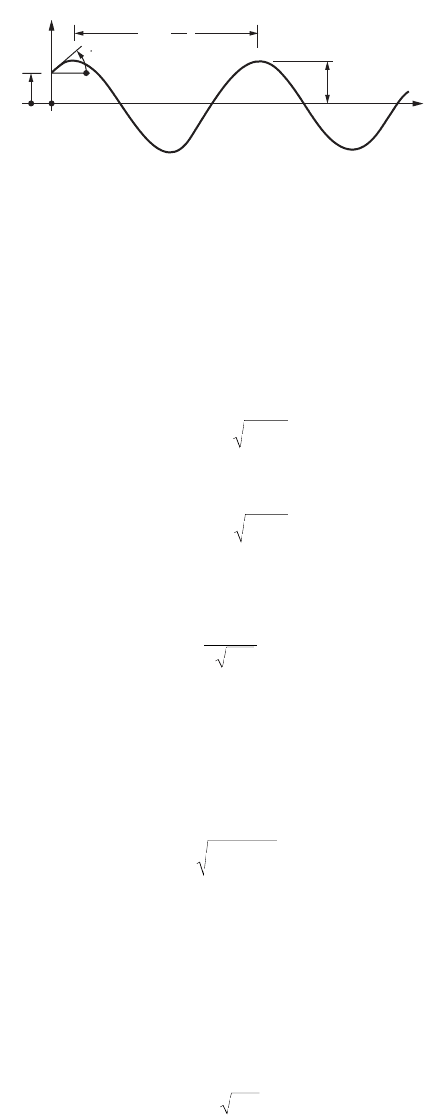
47-164 The Civil Engineering Handbook, Second Edition
Example 47.17: Damped Free Vibration
If the system is not subjected to applied force and damping is presented, the corresponding solution
becomes
(47.368)
where
(47.369)
and
(47.370)
The solution of Eq. (47.368) changes its form with the value of x, defined as
(47.371)
If x
2
< 1, the equation of motion becomes
(47.372)
where x
d
is the damped angular frequency defined as
(47.373)
For most building structures x is very small (about 0.01), and therefore w
d
ª w. The system oscillates
about the neutral position as the amplitude decays with time t. Figure 47.132 illustrates an example of
such motion. The rate of decay is governed by the amount of damping present.
If the damping is large, then oscillation will be prevented. This happens when x
2
> 1; the behavior is
referred to as overdamped. The motion of such behavior is shown in Fig. 47.133.
Damping with x
2
= 1 is called critical damping. This is the case where minimum damping is required
to prevent oscillation, and the critical damping coefficient is given as
(47.374)
where k and m are the stiffness and mass of the system, respectively.
The degree of damping in the structure is often expressed as a proportion of the critical damping
value. Referring to Eqs. (47.371) and (47.375), we have
FIGURE 47.131 Response of undamped free vibration.
x(t)
X
t
x(0)
2π
T =
ω
x(0)
xA t B t=
()
+
()
exp expll
12
lwx x
1
2
1=-+ -
[]
lwxx
2
2
1=-- -
[]
x=
c
mk2
xtAtBt
dd
=-
()
+
()
exp cos sinxw w w
wxw
d
=-
()
1
2
ckm
cr
= 2
© 2003 by CRC Press LLC
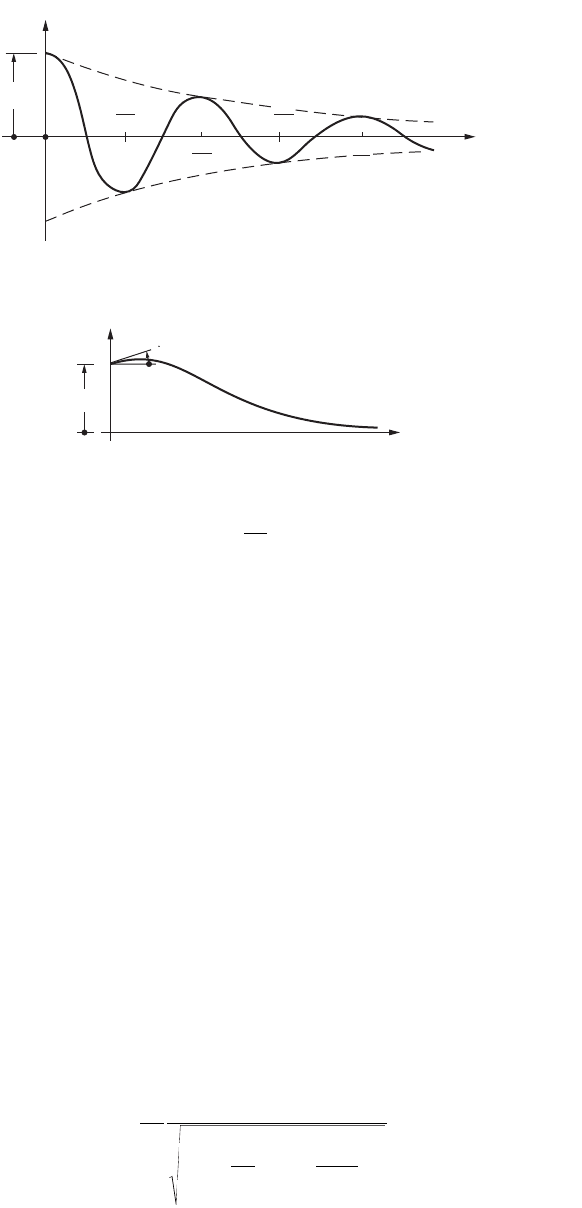
Theory and Analysis of Structures 47-165
(47.375)
x is called the critical damping ratio.
Forced Vibration
If a structure is subjected to a sinusoidal motion such as a ground acceleration of , it will
oscillate, and after some time the motion of the structure will reach a steady state. For example, the
equation of motion due to the ground acceleration (from Eq. (47.362)) is
(47.376)
The solution to the above equation consists of two parts: the complimentary solution given by Eq. (47.364)
and the particular solution. If the system is damped, oscillation corresponding to the complementary
solution will decay with time. After some time the motion will reach a steady state, and the system will
vibrate at a constant amplitude and frequency. This motion, which is called force vibration, is described
by the particular solution expressed as
(47.377)
It can be observed that the steady force vibration occurs at the frequency of the excited force, w
f
, not at
the natural frequency of the structure, w.
Substituting Eq. (47.377) into (47.376), the displacement amplitude can be shown to be
(47.378)
FIGURE 47.132 Response of damped free vibration.
FIGURE 47.133 Response of free vibration with critical damping.
x(t)
x(0)
t
2π
ω
d
4π
ω
d
3π
ω
d
π
ω
d
x(t)
t
x(0)
x(0)
x=
c
c
cr
˙˙
sinxF t
f
=w
˙˙ ˙
sinxxxFt
f
++=-2
2
xw w w
xC tC t
ff
=+
12
sin cosww
X
F
ff
=-
-
Ê
Ë
Á
ˆ
¯
˜
Ï
Ì
Ô
Ó
Ô
¸
˝
Ô
˛
Ô
+
Ê
Ë
Á
ˆ
¯
˜
È
Î
Í
Í
˘
˚
˙
˙
w
w
w
xw
w
2
2
2
2
1
1
2
© 2003 by CRC Press LLC
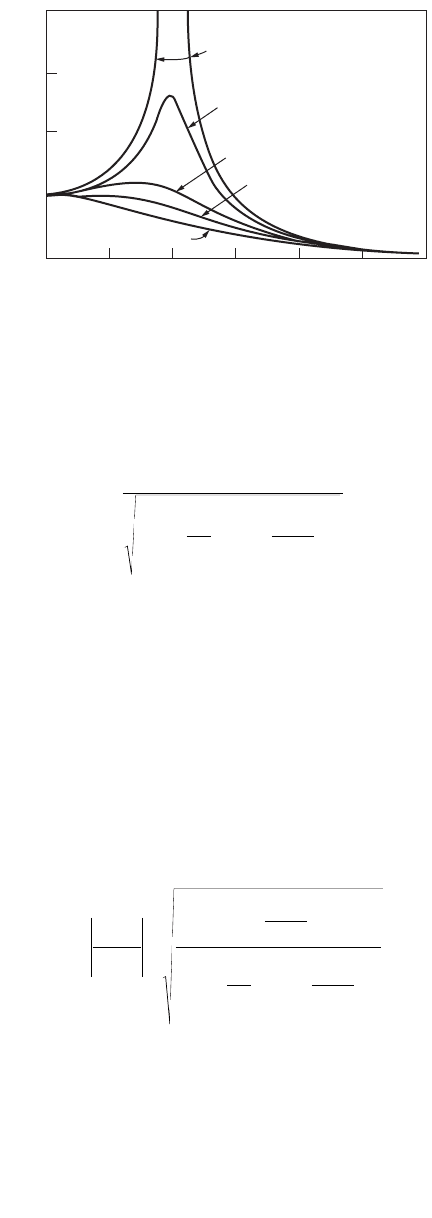
47-166 The Civil Engineering Handbook, Second Edition
The term –F/w
2
is the static displacement caused by the force due to the inertia force. The ratio of the
response amplitude relative to the static displacement –F/w
2
is called the dynamic displacement ampli-
fication factor, D, given as
(47.379)
The variation of the magnification factor with the frequency ratio w
f
/w and damping ratio x is shown
in Fig. 47.134.
When the dynamic force is applied at a frequency much lower than the natural frequency of the system
(w
f
/w 1), the response is quasistatic. The response is proportional to the stiffness of the structure, and
the displacement amplitude is close to the static deflection.
When the force is applied at a frequency much higher than the natural frequency (w
f
/w 1), the
response is proportional to the mass of the structure. The displacement amplitude is less than the static
deflection (D < 1).
When the force is applied at a frequency close to the natural frequency, the displacement amplitude
increases significantly. The condition at which w
f
/w = 1 is known as resonance.
Similarly, the ratio of the acceleration response relative to the ground acceleration may be expressed as
(47.380)
D
a
is called the dynamic acceleration magnification factor.
Response to Suddenly Applied Load
Consider the spring–mass damper system of which a load P
o
is applied suddenly. The differential equation
is given by
(47.381)
FIGURE 47.134 Vibration of dynamic amplification factor with frequency ratio.
4
3
2
D
1
0
012
ω
f
/ω
ξ = 0
ξ = 0.2
ξ = 0.5
ξ = 0.7
ξ = 1.0
3
D
ff
=
-
Ê
Ë
Á
ˆ
¯
˜
Ï
Ì
Ô
Ó
Ô
¸
˝
Ô
˛
Ô
+
Ê
Ë
Á
ˆ
¯
˜
È
Î
Í
Í
˘
˚
˙
˙
1
1
2
2
2
2
w
w
xw
w
D
xx
x
a
g
g
f
ff
=
+
=
+
Ê
Ë
Á
ˆ
¯
˜
-
Ê
Ë
Á
ˆ
¯
˜
Ï
Ì
Ô
Ó
Ô
¸
˝
Ô
˛
Ô
+
Ê
Ë
Á
ˆ
¯
˜
È
Î
Í
Í
˘
˚
˙
˙
˙˙ ˙˙
˙˙
1
2
1
2
2
2
2
2
xw
w
w
w
xw
w
Mx cx kx P
o
˙˙ ˙
++ =
© 2003 by CRC Press LLC

Theory and Analysis of Structures 47-167
If the system is started at rest, the equation of motion is
(47.382)
If the system is undamped, then x = 0 and w
d
= w; we have
(47.383)
The maximum displacement is 2(P
o
/k), corresponding to cos w
d
t = –1. Since P
o
/k is the maximum static
displacement, the dynamic amplification factor is 2. The presence of damping would naturally reduce
the dynamic amplification factor and the force in the system.
Response to Time-Varying Loads
Some forces and ground motions that are encountered in practice are rather complex in nature. In
general, numerical analysis is required to predict the response of such effects, and the finite element
method is one of the most common techniques to be employed in solving such problems.
The evaluation of responses due to time-varying loads can be carried out using the piecewise exact
method. In using this method, the loading history is divided into small time intervals. Between these
points, it is assumed that the slope of the load curve remains constant. The entire load history is
represented by a piecewise linear curve, and the error of this approach can be minimized by reducing
the length of the time steps. A description of this procedure is given in Clough and Penzien (1993).
Other techniques employed include Fourier analysis of the forcing function, followed by solution for
Fourier components in the frequency domain. For random forces, the random vibration theory and
spectrum analysis may be used (Dowrick, 1988; Warburton, 1976).
Multiple Degree Systems
In multiple degree systems, an independent differential equation of motion can be written for each degree
of freedom. The nodal equations of a multiple degree system consisting of n degrees of freedom may be
written as
(47.384)
where [m] = a symmetrical n x n matrix of mass
[c] = a symmetrical n x n matrix of damping coefficient
{F(t)} = the force vector, which is zero in the case of free vibration
Consider a system under free vibration without damping; the general solution of Eq. (47.384) is
assumed in the form of
(47.385)
where angular frequency w and phase angle f are common to all x’s. In this assumed solution, f and C
1
,
C
2
, … C
n
are the constants to be determined from the initial boundary conditions of the motion, and
w is a characteristic value (eigenvalue) of the system.
x
P
k
tt t
o
d
d
d
=--
()
+
Ï
Ì
Ó
¸
˝
˛
È
Î
Í
Í
˘
˚
˙
˙
1 exp cos sinxw w
xw
w
w
x
P
k
t
o
d
=-
[]
1 cosw
mx cx kx Ft
[]
{}
+
[]
{}
+
[]
{}
=
()
{}
˙˙ ˙
x
x
x
t
t
t
C
C
C
n n
1
2
1
2
000
000
000
M
MMMM
M
Ï
Ì
Ô
Ô
Ó
Ô
Ô
¸
˝
Ô
Ô
˛
Ô
Ô
=
-
()
-
()
-
()
È
Î
Í
Í
Í
Í
Í
˘
˚
˙
˙
˙
˙
˙
Ï
Ì
Ô
Ô
Ó
Ô
Ô
¸
˝
Ô
Ô
˛
Ô
Ô
cos
cos
cos
wf
wf
wf
© 2003 by CRC Press LLC

47-168 The Civil Engineering Handbook, Second Edition
Substituting Eq. (47.385) into Eq. (47.384) yields
(47.386)
or
(47.387)
where [k] and [m] are the n ¥ n matrices, w
2
and cos(wt – f) are scalars, and {C} is the amplitude vector.
For nontrivial solution, cos(wt – f) π 0; thus solution to Eq. (47.387) requires the determinant of [[k] –
w
2
[m]] = 0. The expansion of the determinant yields a polynomial of n degree as a function of w
2
, the
n roots of which are the eigenvalues w
1
, w
2
, … w
n
.
If the eigenvalue w for a normal mode is substituted in Eq. (47.387), the amplitude vector {C} for that
mode can be obtained. {C
1
}, {C
2
}, {C
3
}, … {C
n
} are therefore called eigenvectors, the absolute values that
must be determined through initial boundary conditions. The resulting motion is a sum of n harmonic
motions, each governed by the respective natural frequency w, written as
(47.388)
Distributed Mass Systems
Although many structures may be approximated by lumped mass systems, in practice all structures are
distributed mass systems consisting of an infinite number of particles. Consequently, if the motion is
repetitive, the structure has an infinite number of natural frequency and mode shapes. The analysis of a
distributed-parameter system is entirely equivalent to that of a discrete system once the mode shapes
and frequencies have been determined, because in both cases the amplitudes of the modal response
components are used as generalized coordinates in defining the response of the structure.
In principle an infinite number of these coordinates are available for a distributed-parameter system,
but in practice only a few modes, usually those of lower frequencies, will provide significant contribute
to the overall response. Thus the problem of a distributed-parameter system can be converted to a discrete
system form in which only a limited number of modal coordinates is used to describe the response.
Flexural Vibration of Beams
The motion of the distributed mass system is best illustrated by a classical example of a uniform beam
with of span length L, a flexural rigidity EI, and a self-weight of m per unit length, as shown in Fig. 47.135a.
The beam is free to vibrate under its self-weight. From Fig. 47.135b, dynamic equilibrium of a small
beam segment of length dx requires:
(47.389)
in which
(47.390)
km km km
km km k m
km km km
C
C
C
t
nn
nn
nn n n nn nn
n
11 11
2
12 12
2
11
2
21 21
2
22 22
2
22
2
11
2
22
22
1
2
-- -
-- -
-- -
È
Î
Í
Í
Í
Í
Í
˘
˚
˙
˙
˙
˙
˙
Ï
Ì
Ô
Ô
Ó
Ô
Ô
¸
˝
Ô
Ô
˛
Ô
Ô
ww w
ww w
ww w
w
K
K
M MMM
K
M
cos --
()
=
Ï
Ì
Ô
Ô
Ó
Ô
Ô
¸
˝
Ô
Ô
˛
Ô
Ô
f
0
0
0
M
kmC
[]
-
[]
[]
{}
=
{}
w
2
0
xC t
i
i
n
ii
{}
=
{}
-
()
=
Â
cos
1
wf
∂
∂
∂
∂
V
x
dx mdx
y
t
=
2
2
∂
∂
2
2
y
x
M
EI
=
© 2003 by CRC Press LLC

Theory and Analysis of Structures 47-169
and
(47.391)
Substituting these equations into Eq. (47.389) leads to the equation of motion of the flexural beam:
(47.392)
Equation (47.392) can be solved for beams with given sets of boundary conditions. The solution consists
of a family of vibration modes with corresponding natural frequencies. Standard results are available in
Table 47.5 to compute the natural frequencies of uniform flexural beams of different supporting condi-
tions. Methods are also available for dynamic analysis of continuous beams (Clough and Penzien, 1993).
Shear Vibration of Beams
Beams can deform by flexure or shear. Flexural deformation normally dominates the deformation of
slender beams. Shear deformation is important for short beams or in higher modes of slender beams.
Table 47.6 gives the natural frequencies of uniform beams in shear, neglecting flexural deformation. The
natural frequencies of these beams are inversely proportional to the beam length L rather than L
2
, and
the frequencies increase linearly with the mode number.
Combined Shear and Flexure
The transverse deformation of real beams is the sum of flexure and shear deformations. In general,
numerical solutions are required to incorporate both the shear and flexural deformation in the prediction
of the natural frequency of beams. For beams with comparable shear and flexural deformations, the
following simplified formula may be used to estimate the beam’s frequency:
(47.393)
where f is the fundamental frequency of the beam and f
f
and f
s
are the fundamental frequencies predicted
by the flexure and shear beam theories, respectively (Rutenberg, 1975).
FIGURE 47.135 (a) Beam in flexural vibration. (b) Equilibrium of beam segment in vibration.
Small element
beam
(a)
(b)
x
M
V
dx
y
x
dx
∂V
dx
∂x
V +
∂M
dx
∂x
M +
V
M
x
V
x
M
x
=- =-
∂
∂
∂
∂
∂
∂
,
2
2
∂
∂
∂
∂
4
4
2
2
0
y
x
m
EI
y
t
+=
111
222
fff
fs
=+
© 2003 by CRC Press LLC
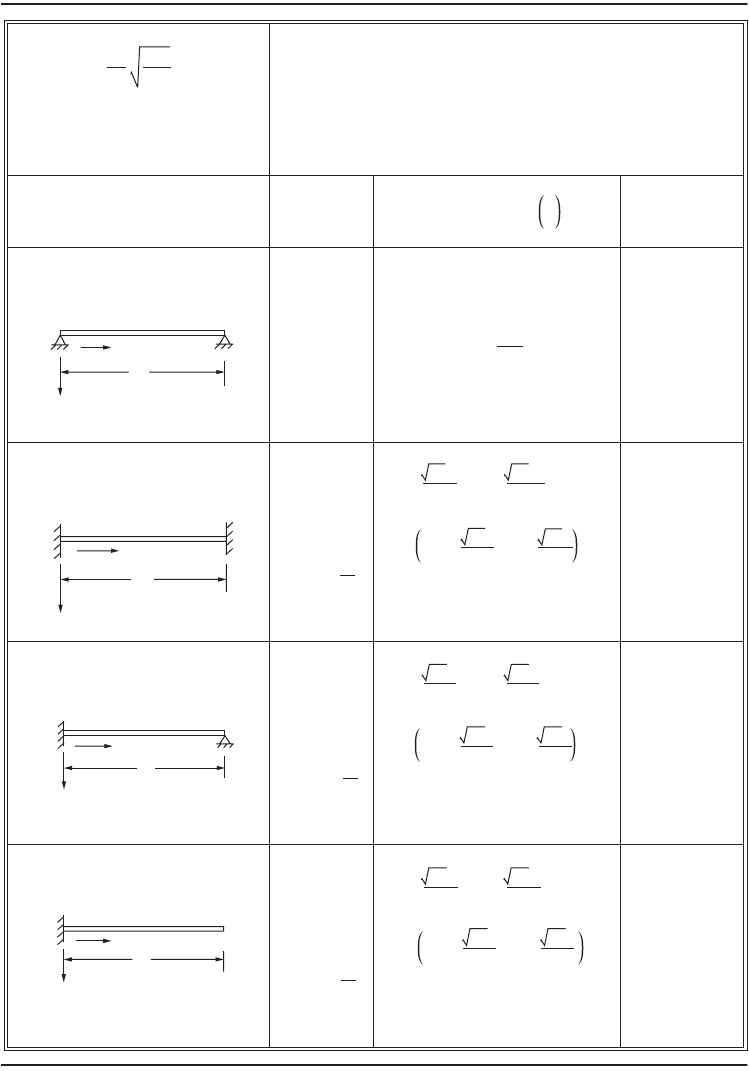
47-170 The Civil Engineering Handbook, Second Edition
Natural Frequency of Multistory Building Frames
Ta ll building frames often deform more in the shear mode than in flexure. The fundamental frequencies
of many multistory building frameworks can be approximated by (Housner and Brody, 1963; Rinne, 1952)
TA BLE 47.5 Frequencies and Mode Shapes of Beams in Flexural Vibration
x
L
y
x
L
y
Fixed - Fixed
Pinned - Pinned
x
x
L
y
y
L
Fixed - Pinned
Cantilever
Boundary conditions
n = 1, 2, 3...
L = Length (m)
EI = Flexural rigidity (Nm
2
)
M = Mass per unit length (kg/m)
K
n
;
n = 1,2,3
Mode shape y
n
x
−
L
A
n
;
n = 1,2,3...
(nπ)
2
nπx
sin
L
cosh
K
n
x
− cos
K
n
x
− A
n
sin h
K
L
n
x
− sin
K
L
n
x
cosh
K
L
n
x
− cos
K
L
n
x
− A
n
sin h
K
L
n
x
− sin
K
L
n
x
cosh
K
L
n
x
− cos
K
L
n
x
− A
n
sin h
K
L
n
x
− sin
K
L
n
x
(2n−1)
2
π
4
2
;
n > 5
0.73410
1.01847
0.99922
1.00003
1.0; n > 4
3.52
22.03
61.69
120.90
199.86
(4n + 1)
2
π
4
2
;
n > 5
15.42
49.96
104.25
178.27
272.03
1.0; n > 3
1.00078
1.00000
n > 5
(2n + 1)
π
4
2
;
22.37
61.67
120.90
199.86
298.55
1.0; n > 5
0.98250
1.00078
0.99997
1.00000
0.99999
f
n
=
K
2
n
π
EI
mL
4
HZ
LL
© 2003 by CRC Press LLC
